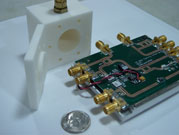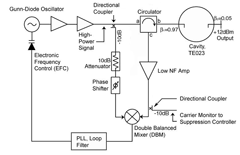Low-Noise Microwave Cavity Oscillator
BOULDER -- Scientists at the National Institute of Standards and Technology (NIST) have patented an oscillator that produces very low noise profiles at microwave frequencies.
Oscillators are devices that ideally produce a signal at a very precise frequency which can be used in electronic devices to tell time or to regulate a multitude of functions. Some common uses for oscillators are in radars, communication and navigation equipment, and in time synchronization. As technology improves, there is a continuing need to find precise, cost-effective oscillators that work at higher and higher frequencies. Historically, the most precise oscillators have been complicated and expensive to build because of the low-power signals that must be used relative to background noise and the shields and special mounts that eliminate sensitivity to the environment.


NIST metrologists have known that high power level without resonant-frequency distortions, the basis of the invention by researchers at NIST, can be used with an air media and even higher power with vacuum, hence, no frequency instability and high signal vs. background noise. Researchers at NIST took a radically different approach to their microwave oscillator. The resonator uses an open chamber, or cavity, that is about the size of a roll of quarters, rigidly defined by an ultra-stiff ceramic housing. The dimensions are such that any frequency that does not agree with a calculated, selected resonant frequency of the cavity is rejected.
Previous best microwave resonators used solid dielectrics, often coupled with cryogenic systems to reduce background noise, but could not operate distortionless at high power levels. High power in an air or evacuated ceramic cavity makes possible a less complex oscillator with less stringent amplifiers, one of the main sources of oscillator noise. At room temperature, the NIST oscillator produces the same, if not better, results than prior laboratory oscillators. The cavity is small and can be produced using any of several relatively inexpensive, ultra-stiff materials. The result is a simpler, low cost, stable oscillator with reference-standard quality and high resistance to the environment.
The larger power fed into the cavity means that a stronger resonance signal can be realized with no degradation. This eliminates need for low-noise signal amplification in most applications that introduces added residual noise.
Extremely stable oscillators have several applications outside of the research environment. A low noise, high-frequency signal is essential for high resolution of radar systems. The same signal can be used to increase the amount of data that is able to be sent through communications satellites. In metrology, these oscillators can be used in atomic spectroscopy and as a reference frequency source for high-frequency tests of devices.
NIST researchers, such as co-inventor Craig Nelson, continue to improve the design, focusing on making it smaller and even more resistant to vibration, for example, and other severe environments. For now, the new oscillator represents a significant advance in the development of oscillator technology.

